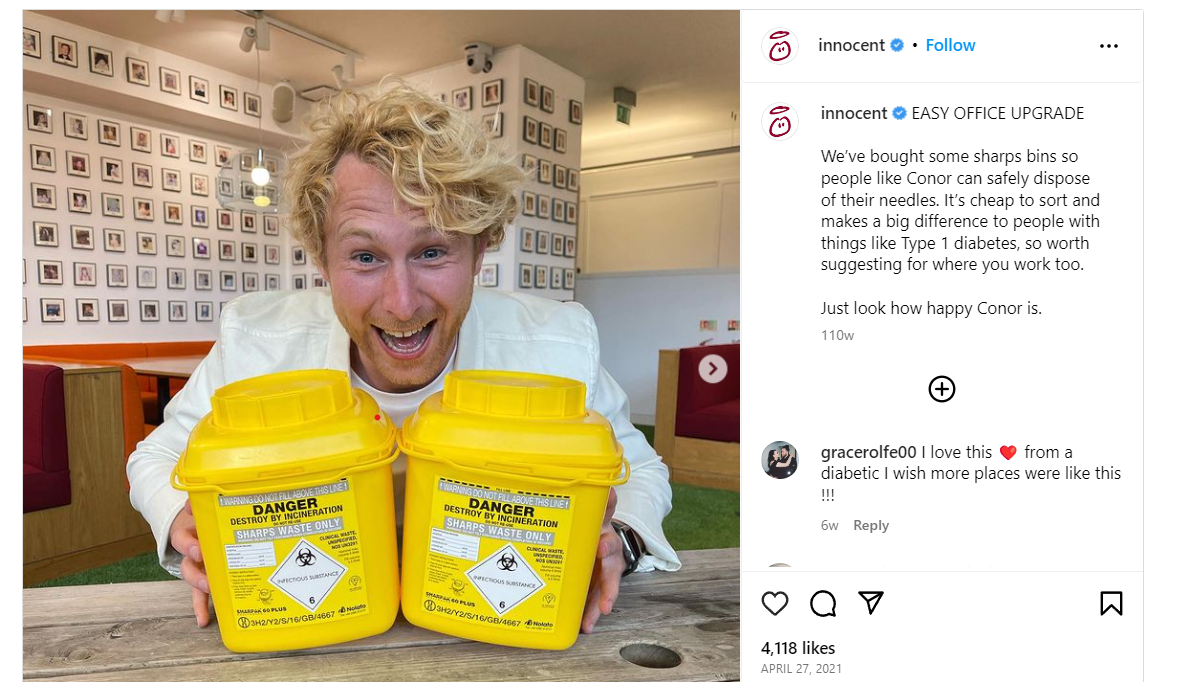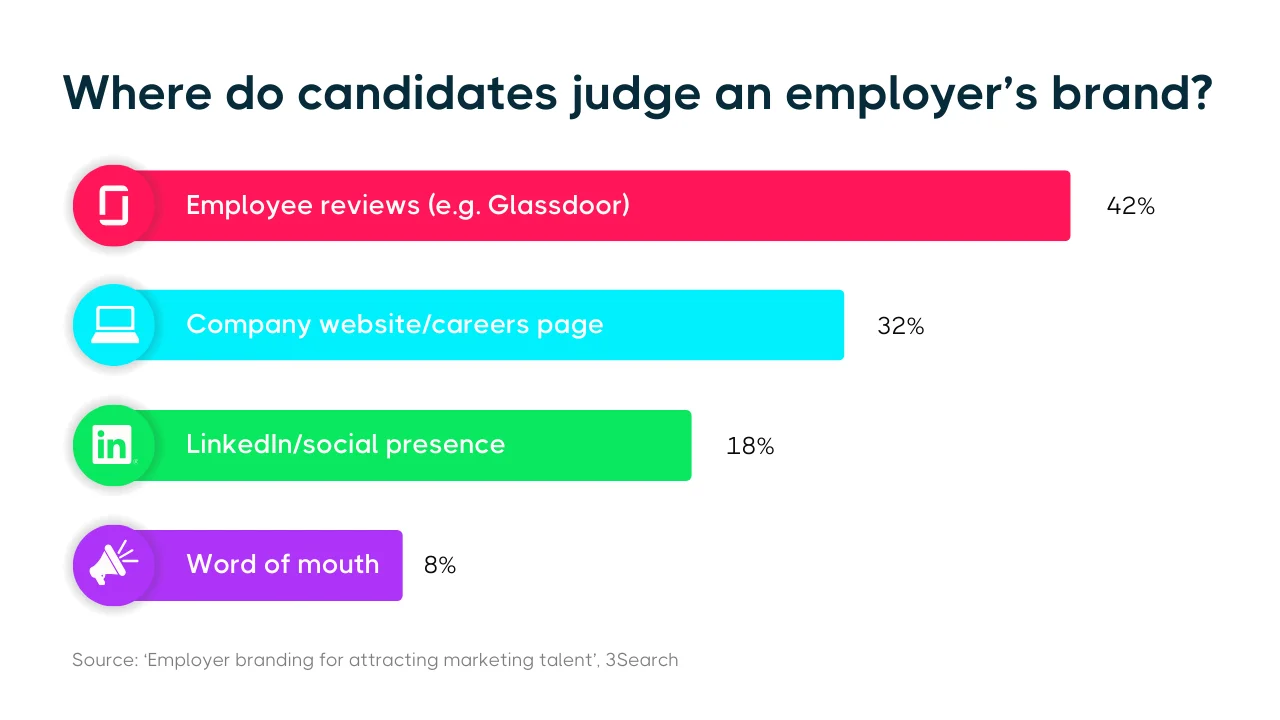Attracting top marketing professionals requires more than a well-written job advert in today's market. With 77% of employees wanting their personal values to align with company values, an employer branding strategy is crucial for attracting and retaining talent.
This article will provide you with actionable steps to create an employer brand that appeals to marketers and improves recruitment outcomes.
Jump to:
- Why employer branding is important
- How to build an employer branding strategy
- What marketers are looking for in your business?
- How to market your business for employment?
- How to measure the success of your employer brand
- How to improve an existing employer brand
What is employer branding?
Your employer brand shapes how people perceive your company as an employer. It communicates your values, workplace culture, and reputation to potential candidates. An employer branding strategy dictates the steps your HR, communications and marketing teams will take to promote your organisation to current and potential employees.
Why is employer branding important?
An employer brand can make or break your recruitment efforts. Those with strong employer brands receive better recruitment results, according to LinkedIn research:
- 75% of job seekers consider an employer’s reputation before applying
- Organisations with strong employer brands experience 50% more qualified applicants
A compelling employer brand not only helps businesses with talent acquisition, but also increases the retention of existing employees. Further research, reveals that a strong employer brand can reduce turnover by 28%.
Attracting applicants without an employer brand is practically impossible. Young brands, such as omre, often choose to partner with a specialist marketing recruitment agency to help them achieve visibility in the market.
How to build an employer branding strategy
To develop an employer brand that attracts top talent, you should consider the following steps.
1. Define your employee value proposition (EVP)
Your EVP encompasses your benefits package and the promises you make to your employees. It makes your company different from your competitors in the eyes of job seekers. To define it, you should answer the following questions:
- Why would a marketer choose to work here instead of another company?
- What career benefits, cultural elements, or unique experiences can you offer?
Focus on tangible benefits that resonate with prospective candidates. For instance:
- Access to cutting-edge tools and technology
- Opportunities to work on high-visibility campaigns
- Emphasis on skill development, such as certifications in platforms like Google Analytics, HubSpot, or SEO tools
Pro tip: Develop this EVP collaboratively with current employees to ensure authenticity. Their input will reflect real benefits and help fine-tune your messaging.
2. Showcase your company culture
Company culture is the a key deciding factor for marketing professionals searching for a new role. Your branding materials should transparently highlight your culture. You can do this by sharing:
- Employee stories: Include reviews, videos, and blogs from current employees. Share their career paths, success stories, and experiences in your organisation.
- Workplace highlights: Rather than stock imagery, share real content of team brainstorming sessions, marketing strategy meetings, or project celebrations.
Marketing talent attraction
Our 'Annual Pay & Hiring Survey' has revealed that 55% of hiring managers intend to hire digital and marketing talent in 2025. Your employer brand is a key tool in ensuring you're attracting the right candidates to your organisation. But, how do you know you're spotlighting the right elements of your business?
Here's what candidates are currently looking for to ensure you speak to the right talent.
Opportunities for growth
Marketers want to know how your organisation will help them grow their career. Our survey of over 1,300 digital and marketing professionals highlighted that career development is crucial in 2025. 11% of respondents placed this first on their list of priorities - above pay, flexible working and culture.
In your employer brand, you should highlight learning and development opportunities, such as:
- Certifications in tools like Google Ads, Meta Blueprint, or HubSpot Marketing Hub.
- Mentorship programmes with experienced marketing leaders.
- Clear promotion pathways and internal training sessions.
Pro tip: Include statements in job adverts that highlight career development growth. For instance, “This role includes annual professional development funding” or “Career progression opportunities within six months.”
Flexible and hybrid work options
The demand for flexible working continues to rise. Marketing roles often lend themselves well to remote or hybrid setups.
A survey of over 1,000 professionals by tech retailer, Currys, revealed that 38% of workers prefer hybrid working. Highlighting flexibility in your employer branding signals that your organisation is adaptable and respects work-life balance.
Plus, remember that hybrid working expands your talent pool. For example, we helped Lintbells hire a CRM Manager based in Wales, while their head offices are in Hertfordshire, England.
Branding for recruitment
Now that you've built your employer branding strategy, you need to know how to share it. Here are some platforms for your recruitment marketing strategy.
Careers page
Your careers page serves as the cornerstone of your employer branding strategy. To attract talent, it needs to be visually appealing, user-friendly, and keyword-optimised.
What to include:
- Employee stories: Highlight the stories of professionals who grew their careers within your organisation.
- Detailed job postings: Ensure job ads are clear and concise. Include specific skills, such as SEO, campaign management, or PPC advertising experience.
- Cultural insights: Share photos, videos, or blogs about team-building activities, company values, and how teams collaborate.
Pro tip: Optimise for SEO by using keywords like “marketing career opportunities” or “digital marketing roles” to improve visibility.
Social media
Social media platforms are invaluable for employer branding. Marketing professionals often explore company pages on LinkedIn, Instagram, and X to gauge a workplace’s culture.
How to use social media for employer branding:
- Post updates on successful campaigns your marketing team has delivered
- Share “behind the scenes” content, like policy changes or team socials
- Celebrate employee milestones, such as promotions or awards
Looking for inspiration? innocent drinks are a great example of a brand that places it's employees at the heart of its marketing strategy. Not only do they highlight their employee-led initiatives on LinkedIn (such as their doggie club), but they also feature tours of their offices on Instagram and TikTok.

Other platforms to consider
In a recent poll of over 250 professionals, almost half told us the first place they review an employer brand is their Glassdoor profile. If you don't have a presence on the platform, it's time to build your profile - highlighting the benefits of joining your company and positive employee reviews.

How to measure the success of employer branding
As with any new strategy, it's important to measure the outcomes to reflect and improve. To do this, here are some metrics we'd recommend tracking.
Candidate engagement
For candidate engagement, you should track:
- The number of applications per job posting.
- Time spent on your careers page.
- Interactions on social media posts related to recruitment.
These factors give you a strong benchmark to track the visibility of your employer brand.
Retention rates
Retention rates provide a clear indicator of how well your employer branding resonates with current employees. You should monitor employee tenure to assess its success. Companies with strong employer brands should retain employees longer, which reduces recruitment costs and improves team cohesion.
How to improve your employer brand
With an established employer brand, you'll always be looking to improve. Here are some ways you can take your branding strategy to the next level...
Partner with employees
Your employees are your best advocates. Encourage them to share their workplace experiences on social platforms and during recruitment events.
For instance, our parent company, 11 Investments, shares stories of those who started their career with us as graduates in January or September. This is when they actively hire cohorts of graduate recruitment consultants. This social media campaign helps showcase the future potential employees could have with the business.
Leverage employer review sites
According to HR platform, HiBob, 65% of job seekers aged 18-44 look at Glassdoor reviews when deciding to accept a job offer and sign at a new company. You should ensure your profiles on Glassdoor and Indeed reflect your brand positively. Make sure you:
- Regularly update your company profiles, sharing accurate descriptions of your EVP and company culture.
- Respond constructively to both positive and negative reviews.
- Encourage satisfied employees to leave reviews highlighting specific aspects of the workplace, like learning opportunities or team dynamics.
Maintaining an active and authentic presence on these platforms are key to having job offers accepted.
For more candidate attraction support, get in touch!
A strong employer branding strategy is essential for marketing talent attraction. To learn more about marketing recruitment best practice, get in touch with the team. We can offer tailored advice for your hiring strategies.




